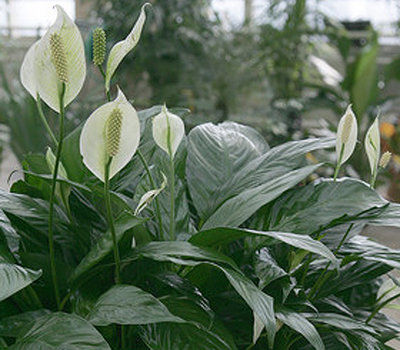As summer comes to a close, all of us are spending more time indoors. That means it’s time to spruce up our homes with houseplants.
Whether you have a home office, a small desk for studying or just a chair where you like to read, adding a few houseplants to clean the air and bring a touch of nature inside is a great idea. There are plants that thrive with little care and are easy to grow, even in lower light. I know — my house is quite dark, and my plants are happy and healthy.
Plain, green leafy types do best where the light is low. My favorite upright plants include schefflera, Hawaiian arboricola, philodendrons like selloum and split-leafed, Chinese evergreen, spathiphyllum (peace lily), cast-iron plant (aspidistra), parlor palm, snake plant and ferns. They are native to the jungle understory and grow naturally in low-light areas.
Hanging plants that I grow in these same conditions are heart-shaped philodrendrons, pathos and grape ivy.
Many common houseplants help fight pollution indoors. They’re reportedly able to scrub significant amounts of harmful gases out of the air through the everyday processes of photosynthesis. Some pollutants are also absorbed and rendered harmless in the soil.
Plant physiologists have long known that plants absorb carbon dioxide and release oxygen as part of the photosynthetic process. Researchers have found that many common houseplants absorb benzene, formaldehyde and trichloroethylene, as well.
Most of these household plants evolved in tropical or subtropical forests, where they lived on light filtered through the branches of taller trees. Because of this, their leaf composition allows them to photosynthesize efficiently in relatively low-light conditions, which in turn allows them to process gases in the air efficiently.
Some houseplants are better at removing formaldehyde from the air, while others do a better job on benzene. However, none is much help when it comes to tobacco smoke. But there are enough known plants that do a good job of removing pollutants from the air we breathe to cause us to view houseplants as more than just attractive decorative features.
One such popular houseplant is the common succulent Aloe vera (now renamed Aloe barbadensis), also known as “medicine plant.” Many people already have one in a bright kitchen window because of the soothing, healing properties of its viscous inner tissue on burns, bites and skin irritations.
Soil and roots were also found to play an important role in removing airborne pollutants. Microorganisms in the soil become more adept at using trace amounts of these materials as a food source as they are exposed to them for longer periods of time. Their effectiveness is increased if lower leaves that cover the soil surface are removed, so there is as much soil contact with the air as possible.
NASA studies generated the recommendation that you use 15 to 18 good-sized houseplants in 6- to 8-inch diameter containers to improve air quality in an average 1,800-square-foot house. The more vigorously they grow, the better job they’ll do for you.
At a glance
These are some of the best indoor pollution-fighting plants:
**Hedera helix — English ivy
**Chlorophytum comosum — spider plant
**Epipiremnum aureum — golden pothos
**Spathiphyllum Mauna Loa — peace lily
**Aglaonema modestum — Chinese evergreen
**Chamaedorea sefritzii — bamboo or reed palm
**Sansevieria trifasciata — snake plant
**Philodendron scandens oxycardium — heartleaf philodendron
**Philodendron selloum — selloum philodendron
**Philodendron domesticum — elephant ear philodendron
**Dracaena marginata — red-edged dracaena
**Dracaena fragrans Massangeana —
cornstalk dracaena
**Dracaena deremensis Janet Craig —
Janet Craig dracaena
**Dracaena deremensis Warneckii —
Warneck dracaena
**Ficus benjamina — weeping fig
Jan Nelson, a California certified nursery professional at Plant Works in Ben Lomond, will answer questions about gardening in the Santa Cruz Mountains. E-mail her at ja******@*ol.com.













